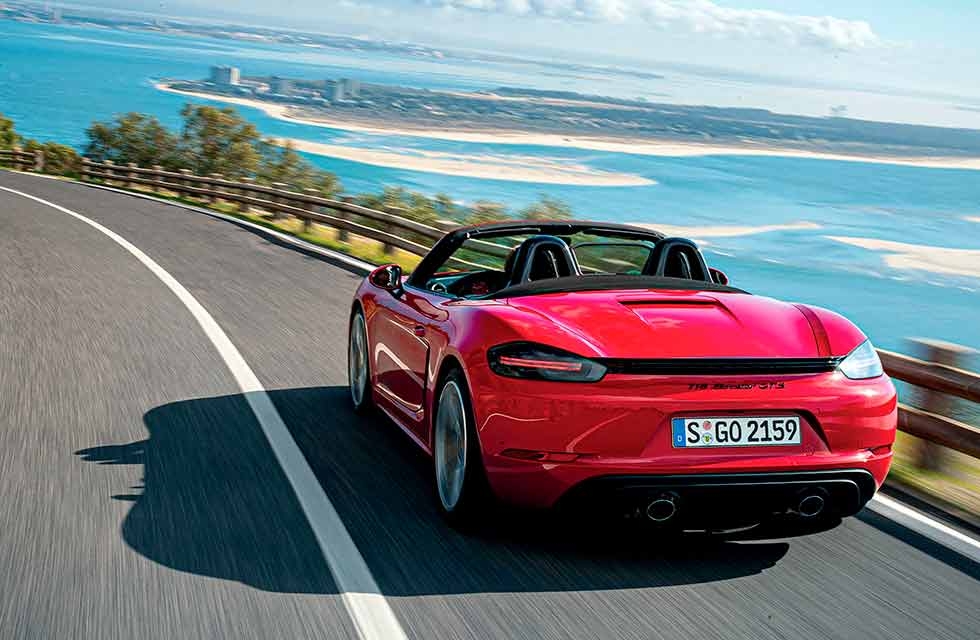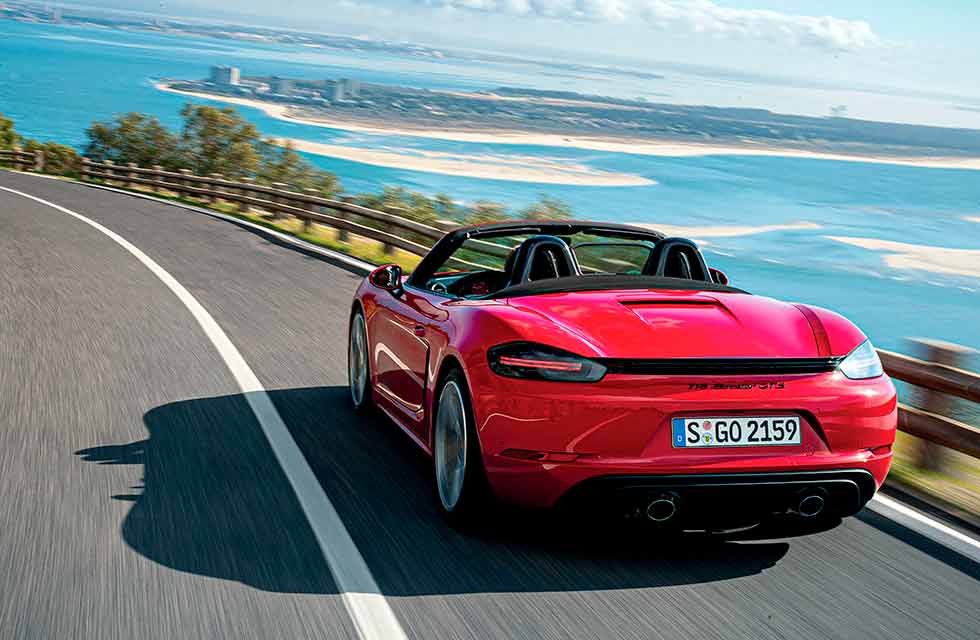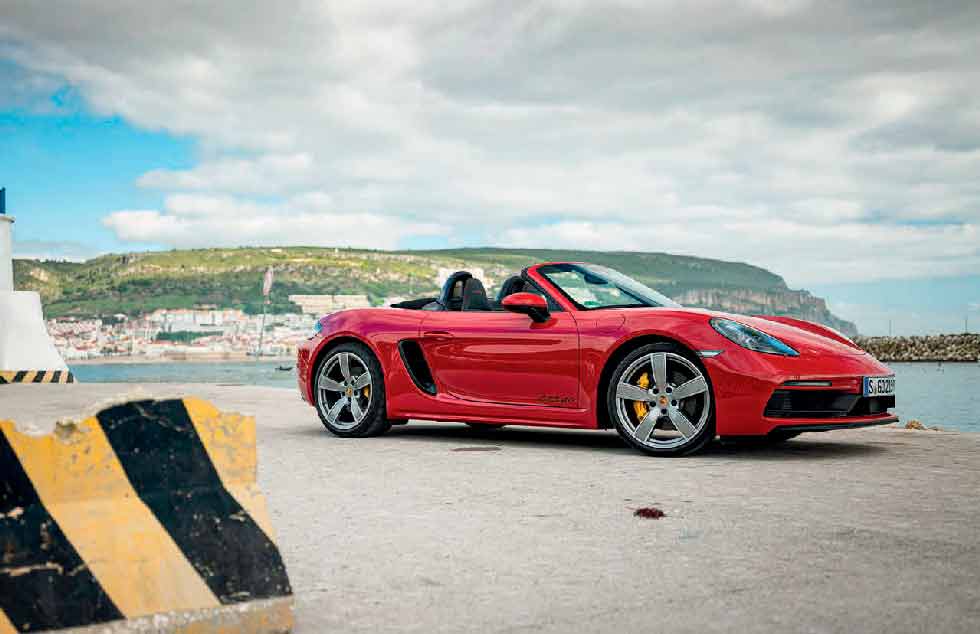
Porsche buyers wanting a 982 718 with six-cylinder power, but not the track-ready chassis (or cost) of a Spyder or GT4, now have a very tempting proposition in the shape of the GTS 4.0 twins… Words Shane O’Donoghue. Photography Porsche.
SIX PACKED FIRST DRIVE GTS 4.0 TWINS 982
Take to social media for a discussion about the four-cylinder boxer engines Porsche launched for its 982-generation 718 Boxster 982 and Cayman 982C and you’re unlikely to hear the quiet voices of those that don’t hate these powerplants. I’m not afraid to count myself among those in the minority, mostly because of the massive increase in torque available across the rev range, allowing you exploit the inherent goodness of the 718 chassis to the full. Don’t get me wrong: like anyone with ears, I prefer the dulcet tones of a naturally aspirated flat-six over the blaring turbocharged menace of the four-pot, but unless you’re being particularly churlish, the four-cylinder 718s can hardly be considered duds in the bloodline. Nonetheless, Porsche took widespread criticism to heart and set about looking at how it could return six-cylinder power to its mid-engined machines. The project culminated with the launch of the mighty 718 Spyder 982 and GT4, which we dutifully tested to the full in Drive-My EN/UK.

Unquestionably, the 718 GT4 982C and Spyder 982 are epically good cars. They’re exciting to drive, they feature adjustable suspension making them suitable for serious track work, the new engine (more of which in a moment) is sublime and, well, they look sensational. These cars are not, however, perfect; I must confess, I couldn’t live with the fiddly roof of the Spyder, so, unless I lived somewhere it never rained, it wouldn’t be on my list of cars to own. Admittedly, I’d swap one of my kidneys for the 718 GT4, but I’d wonder if its apex-sniffing suspension and attention-grabbing aerodynamic upgrades would be too ‘full on’ for everyday use. Overriding all of those considerations, of course, is the small matter of pricing and availability.
THE ELECTROMECHANICAL STEERING IS TEN PERCENT MORE DIRECT THAN THE 981’s RACK AND IS BASED ON THE SYSTEM INCLUDED WITH THE 991-GENERATION 911 TURBO
The base 718 Cayman — a fantastic car by any measure, remember — stands at £44,790 at the time of writing, while the GT4 (with a long waiting list) is £75,348. The Spyder, meanwhile, is about £27,000 more than the entry-level 718 Boxster 982. Yikes.
In fairness, those range-toppers get a lot more than just the new engine, which goes a long way to justifying the pricing. Even so, I suspect there are more Porsche buyers out there that do want just that new engine in a version of the Cayman or Boxster they could use every day. And now, thanks to the launch of the 982 718 GTS 4.0 models, their wishes have been granted. That little 4.0 suffix is important here (and I’m sure Porsche’s marketing people aren’t unhappy about its vague link with the 997 Gen II GT3 RS 4.0 of 2011) due to the fact the 982 line-up already boasted a GTS, taking the forms of the 360bhp models powered by an upgraded version of the 2.5-litre flat-four.
LIGHTS ALIVE
Fans of the GTS specification in general won’t be disappointed by what they find in the new 4.0 variants — the same theme of upgrades is carried over to the newer models. Dark detailing is everywhere you look, giving the GTS models a more menacing appearance to set them apart from the regular and S-badged 718s. The new mid-engined marvels don’t get the all-new downforce-producing bodywork of the GT4 and Spyder, but there’s a partially black Sport Design front apron featuring a modest aerodynamic lip and darkened surrounds for the standard bi-xenon headlights. The LED rear lights are given the same treatment, there’s black ‘GTS 4.0’ script on the doors and black badging at the rear, while the standard alloy wheel is a ten-spoke twenty-inch design finished in Satin Gloss Black with red brake callipers peeking through from behind.
DARK DETAILING IS EVERYWHERE YOU LOOK, GIVING THE GTS MODELS A MORE MENACING APPEARANCE TO SET THEM APART FROM THE REGULAR AND S-BADGED 718s
You’ll note the massive fixed rear wing of the 718 GT4 is nowhere to be seen on the Cayman GTS 4.0, but the GT4 and Spyder’s sports exhaust system has been carried over unchanged, meaning wide-spaced twin outlets in an angry black diffuser. Badging aside, this is the easiest way for us anoraks to tell a GTS 4.0 apart from the earlier, smaller engined GTS, which displayed its two exhaust tips together in the middle of the back bumper. The well-trodden GTS path continues inside the 4.0 cars, and that’s no bad thing, because it means lots of luxurious Alcantara. In the Cayman, the suede-like material is found on the A-pillars and headlining, though both cars get the smooth stuff on the glorious steering wheel, the centre console, the gear lever, the armrests, door closing handles and partially upholstering the fabulous Sports Seats Plus. The headrests feature the GTS logo, which is also found on the door sills, prominent rev counter and on the start-up screen of the Porsche Communication Management (PCM) touchscreen. Combined, these elements make for a dark cabin as standard (despite lots of high-gloss silver trim), which is why it’s worth investing in a few extras to finish the stitching, seatbelts and even the rev counter in red or grey. Have a play with the online configurator and you’ll see there’s a lot of customisation available.

Do that and you’ll notice you can’t have a PDK gearbox in the GTS 4.0 models… yet. Fret not! It’s coming, but not until late this year at the very earliest. That means ‘making do’ with the six-speed manual cog swapper. Now, I’d take the manual every time, but I wouldn’t be doing my job if I didn’t point out a few things about this particular gearbox for buyers to consider before placing an order. It has the same set of ratios as the GT4, which means you can hit 80mph in second gear. Sure, that helps the 0-62mph time, but if that’s all that matters to you, then you should stick with turbocharged four-cylinder power in the old (and, awkwardly for Porsche, faster accelerating) GTS 2.5. The thing is, the manual gear shift is so deliciously weighted and the engine so responsive and melodic that you want an excuse to change gear as often as possible. No, it’s not rational. And no, it doesn’t help you go faster, but yes, it makes up a big part of the appeal of owning a powerful sports car. The GTS’s gearing detracts from that when you’re having fun on the public road because you simply don’t need to change gears very often.
When you change down, you’ll be met with the second issue we have with this transmission. It features Porsche’s rev-matching system as standard, which, it must be said, is fabulously well-judged and rpm-perfect, but — and this is a big BUT for me — there’s no simple way to switch it off (you have to disable the Porsche Stability Management (PSM) system). In other words, drivers keen to learn, perfect or just employ heel-and-toe down-shifts and throttle blips may find themselves a little frustrated. The forthcoming PDK option should at least alter the gearing for more changes, but a few minor tweaks to the manual gearbox would be all that’s needed to make it the perfect companion to the engine.
And this, surely, is why we’re here. I know, the sound is pretty much all that matters to most (and it does sound sublime), but Porsche’s engineers went to a lot of trouble to bring this engine to life, so the least you can do is read a paragraph or so about their efforts.
Officially, the story starts with the 992-generation 911’s three-litre 9A2EVO unit, but without its duo of turbochargers. And a different bore and stroke, hence new pistons, connecting rods and cylinder heads. Plus, of course, the valves and crankshaft, not to mention the inlet manifolds. We’re struggling to see what was kept, to be honest, and wonder if factory engineers somehow convinced Porsche’s bean-counters all they were doing was tweaking the 911’s engine to make it into the high-revving, naturally aspirated flat-six of a 718 buyer’s dreams.
HOLD FIRE
Obviously, Porsche had to peg back GTS 4.0 power in a bid not to outshine the GT4 and Spyder, but only twenty ponies were dropped, resulting in output of 394bhp produced at 7,000rpm (instead of 7,600rpm), while the rev limiter is set 200rpm shy of the GT4’s at 7,800rpm. Without doing a back-to-back drive, it would be a lie to say the GTS 4.0 feels appreciably slower or its engine any less rev-happy. In truth, the almost unaltered torque output is probably more important in regular driving, and it still tops out at 310lb-ft, between 5,000 and 6,500rpm (the GT4’s engine holds that level for 300rpm longer). Number junkies will have spotted that the old GTS 2.5’s engine has a little more torque (up to 317lb-ft) available over a much wider band of revs (1,900-5,500rpm), meaning the older car should actually feel quicker most of the time, but, as we’ve already established, speed isn’t everything — the new GTS is all about engagement with the driver.
To that end, though the GTS 4.0 models don’t get the track-focused suspension set-up of their loftier siblings, they do benefit from several enhancements to help owners get the most out of each car in everyday use. Sports suspension with Porsche Active Suspension Management (PASM) is standard, bringing with it a twenty-millimetre drop in ride height (and hence centre of gravity), though it’s worth noting buyers can opt for a more comfortable setup with half that drop if they so wish. As before, the electromechanical steering is ten percent more direct than the 981’s rack and is based on the system included with the 991-generation 911 Turbo.
Porsche fits the Sport Chrono package as standard to the GTS 4.0 models, including the rotary switch on the steering wheel to allow quick selection of Normal, Sport, Sport Plus and Individual driving settings. These affect the throttle response, PASM, the sports exhaust, the stop-start system (which is linked with the engine’s clever cylinder deactivation function to save fuel and reduce emissions) and even the retractable rear spoiler. Owners can also download the Track Precision smartphone app as part of the GTS 4.0 package, but perhaps the most important inclusion is Porsche Active Drive Mounts. These automatically soften or firm up, the theory being more comfort and less noise at one end of the spectrum and better control of the moving masses at the other end, which should help with a ‘spirited’ attack of bends.
The combination of the lower suspension and these mounts certainly makes for fast cornering. Not only that, but the GTS 4.0 feels malleable and playful while also gripping hard and keeping unwanted body movements to a minimum. At sane speeds, it’s incredibly rewarding, the fast steering and inherent firmness of the suspension marrying with the rigid chassis structure to give the driver a highly enjoyable and fuss-free experience. The high grip levels don’t mean it’s inert, but, all the same, this car’s chassis is forgiving at the limit, though you won’t often broach it on the public road, at least not in the dry.
FEEL THE DIFFERENCE
Aiding the GTS 4.0’s ability to exit tight corners with all of its power going in the right direction is Porsche Torque Vectoring (PTV) and a mechanical limited-slip differential. The former adds braking pressure to the rear wheel at the inside of a corner (to help the car pivot into the bend), while the latter sends more torque to the outside wheel on application of the throttle. Very little of this are you aware of working, of course, but you’ll notice that stability and traction control systems aren’t called into action very often, even when you’re pushing on. And for those skilled enough to take further liberties, the GTS 4.0 models come with a selectable PSM Sport mode. In the dry, there’s no fear for your no-claims bonus when you push this, so biddable is this car’s chassis.
All of the above could be said of both the Boxster and Cayman GTS 4.0. Take it from me, they’re both exceptionally fun and accomplished cars to drive on the public highway. Furthermore, they’re usefully cheaper and more practical than their Spyder and GT4 siblings and, perhaps unsurprisingly, better suited to regular road use. The Boxster does have the benefit of less material between your ears and the wail of the exhaust, of course, but, at the end of the day, coupe or roadster is a matter of personal choice. Whatever you do, don’t take to social media to discuss the matter!
Facing page Perfectly at home on the public road, the GTS 4.0 models are also happy to be used as weekend track toys.
Below The GTS 4.0 twins offer a better, more usable proposition for regular driving than the Spyder or GT4.
Facing page Red double stitching and carbon trim add a touch of class.
Below Ravishing in red, the GTS 4.0 is a belter of a Boxster.
Above Is there a better model than the Boxster GTS 4.0 in Porsche’s current product line-up for fast fun in the sun?
Facing page Alcantara-trimmed GTS 4.0 interior is far more hospitable than the GT4’s cabin.






